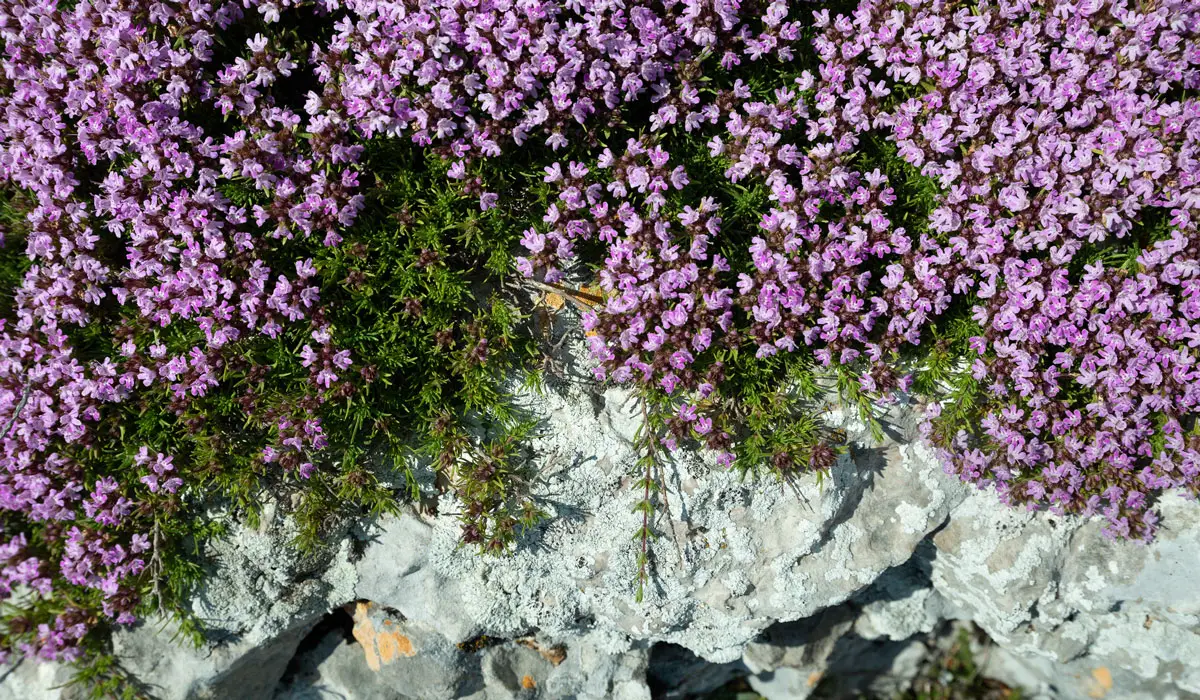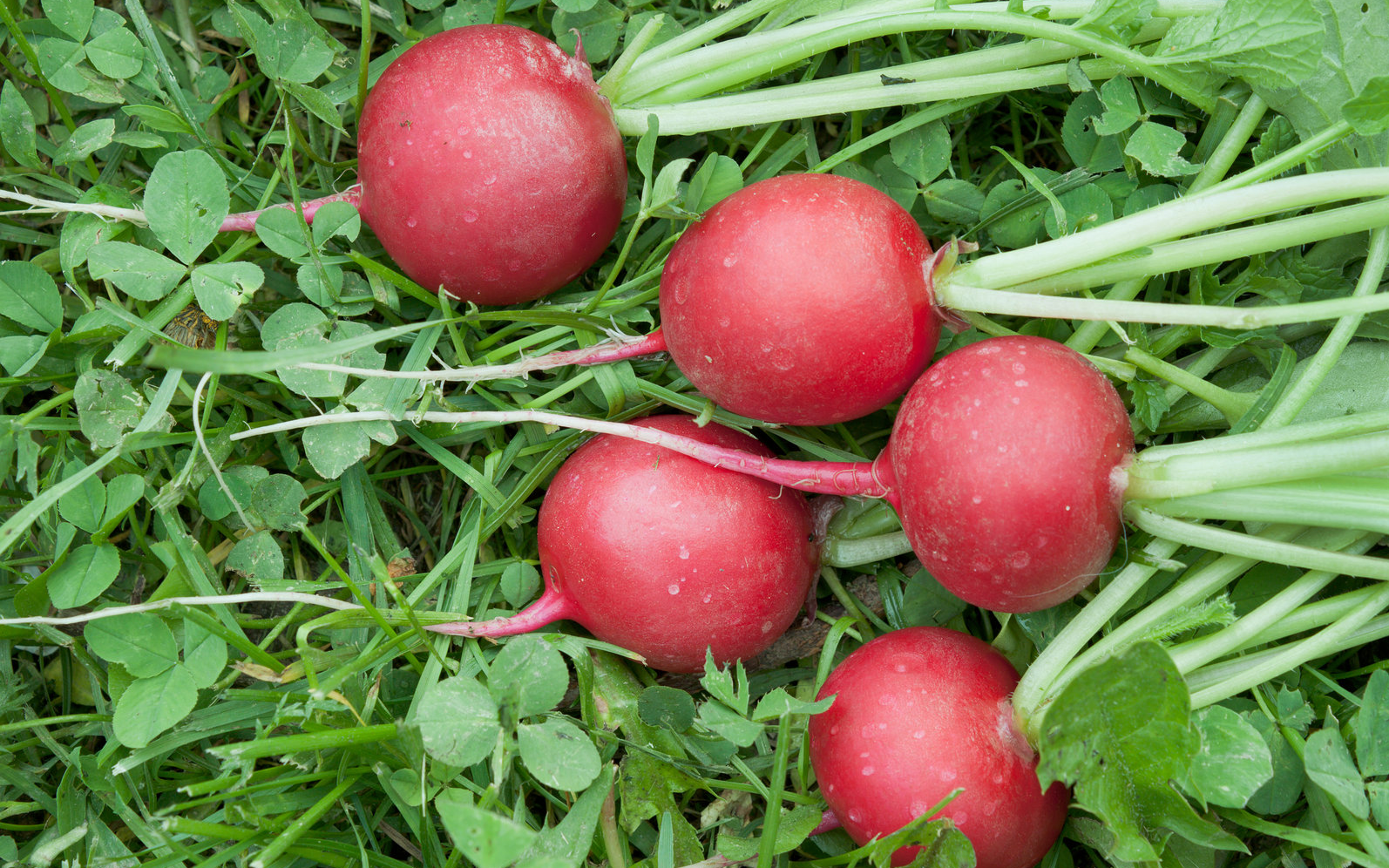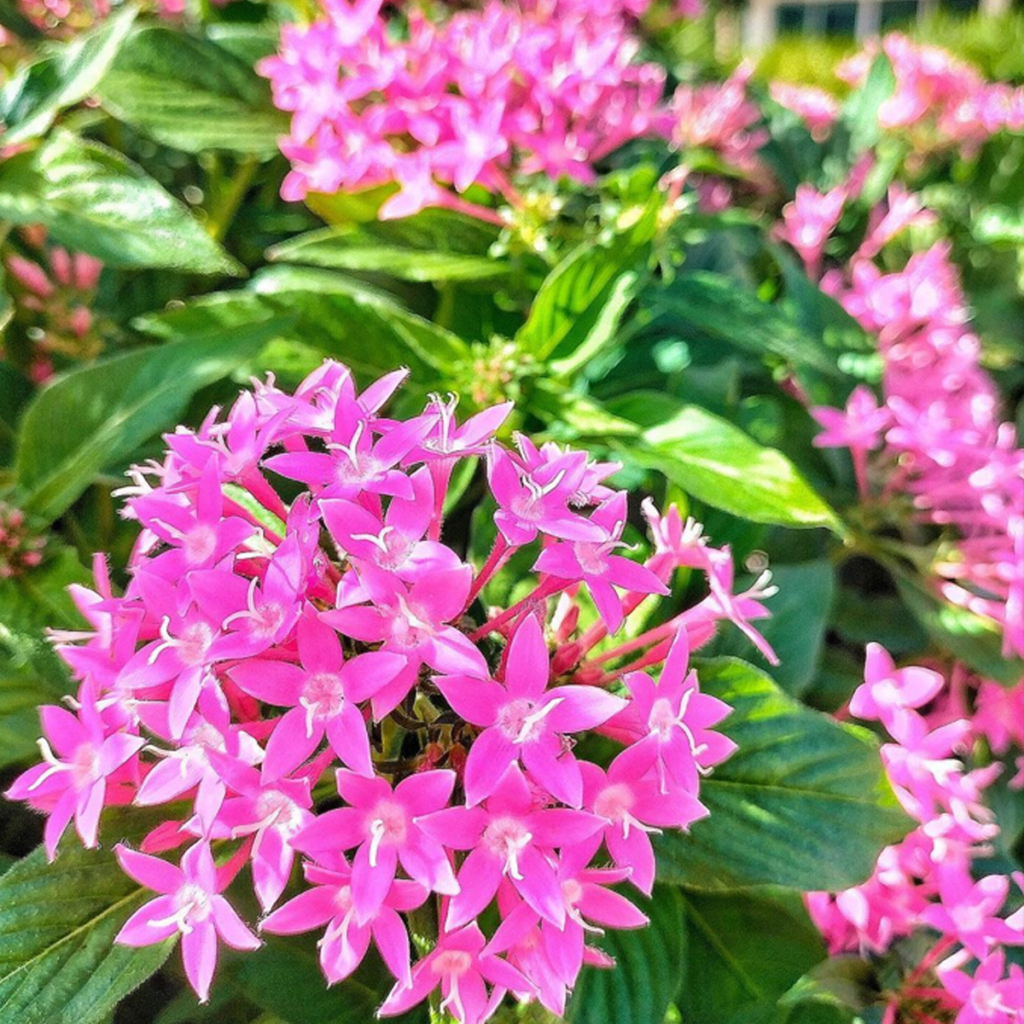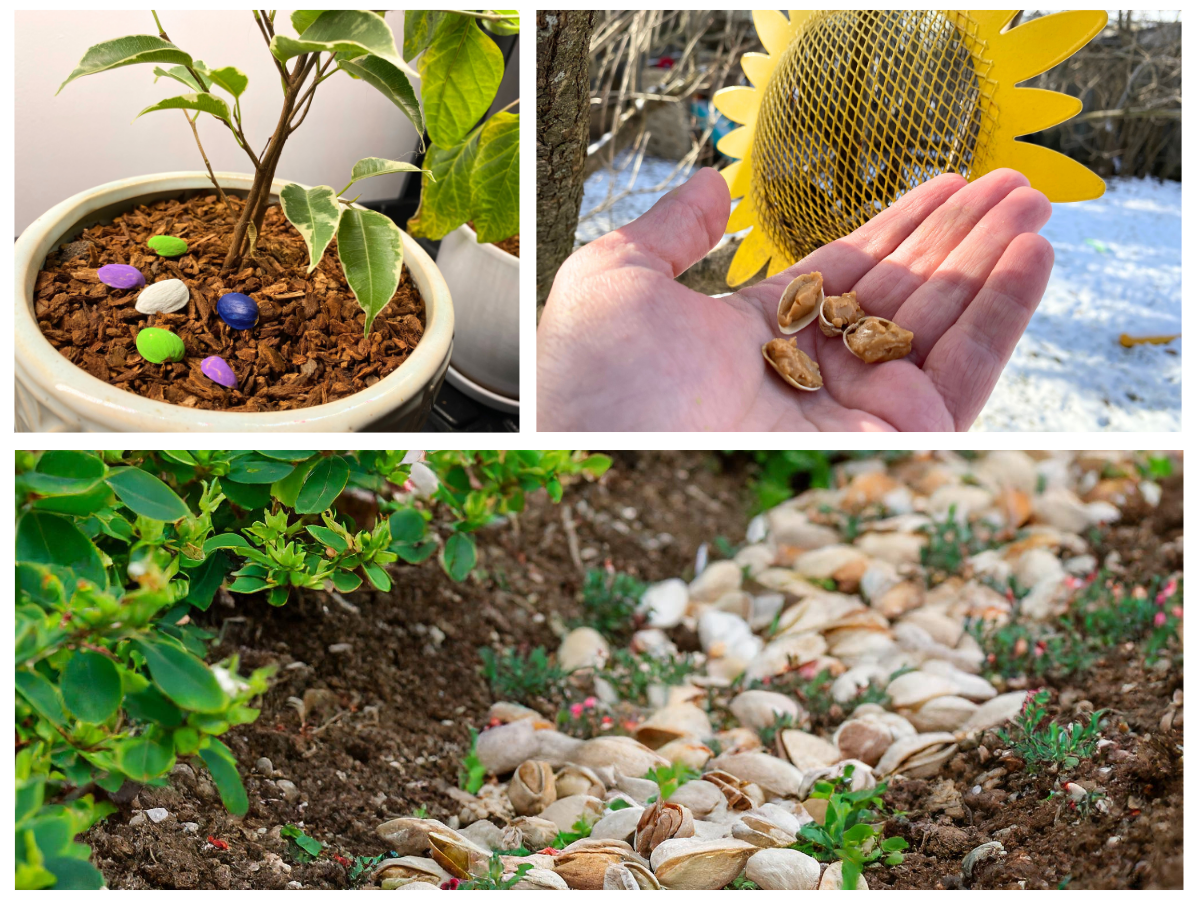11 No Mow Ground Cover Plants To Replace Your Grass With

Figuring out what kind of plant you want to add to your garden and/or landscape can be challenging. After all, there are so many great options!
One of the best options is to go with ground-cover plants. Because many of these grow prolifically, they can easily spread across your lawn, filling up any empty space.

I love adding ground covers to my yard and garden, they cut down on maintenance time and can even add a pop of color to an otherwise sea of green.
If you want to know more about which ground cover plants you should add to your lawn, you’ve come to the right place. Here are the top 11 no-mow ground cover plants to replace your grass with.
1. Creeping Charlie (Glechoma hederacea)

Are you looking to add a little greenery to your garden and/or flower box? If so, you may want to add some Creeping Charlie! This fast-growing plant is very low-maintenance.
Though it is traditionally very resistant to plant diseases and pests, it may suffer from bacterial disease if the soil gets too wet. This is because Creeping Charlie prefers damp soil, but not soaked.
Keep in mind that this is a very aggressive plant, so it does have the potential of killing other flowers in your garden. However, as long as you keep it pruned and in check, you should be fine. Check out this helpful guide:
| Botanical Name: | Glechoma hederacea |
| Growth Rate: | 4-6” tall |
| Native Range: | Europe and Asia |
| Hardiness Zones: | 5-9 |
| Dangers: | Sometimes toxic to horses |
| Soil Needs: | Fertile, well-draining soil |
| Exposure: | Partial sun |
| Ease of Care: | Low-maintenance |
| Diseases: | Not applicable |
| Propagation: | Place a cutting directly on the soil and watch it take off! |
| Fertilizer: | Every 1-2 months |
| Pests: | Not applicable |
| Blooming Period: | Mid-spring to early summer |
| Pruning: | Prune as needed |
| Water needs: | Every 3-4 days |
2. Creeping thyme (Thymus serpyllum)

Though they may sound similar, Creeping Thyme is nothing like Creeping Charlie. In fact, they’re two completely different plants (though they are a part of the same family).
Generally, Creeping Thyme is pretty easy to take care of as long as it has access to either a rocky or sandy, well-draining soil and at least six hours of full sunshine per day.
Though it can go a little over a week in between waterings, it can’t do so if the temperatures are too extreme.
Check out the below care guide for more information on how often to water your Creeping Thyme plant during the summer season.
| Botanical Name: | Thymus serpyllum |
| Growth Rate: | 2-6” tall and 6-18” wide |
| Native Range: | Europe |
| Hardiness Zones: | 2-9 |
| Dangers: | Non-toxic |
| Soil Needs: | Well-draining, rocky soil |
| Exposure: | At least 6 hours of full sun per day |
| Ease of Care: | Low-maintenance |
| Diseases: | Root rot |
| Propagation: | Divide the plant in late spring and early summer; place the cutting in a small pot with soil and at least 6 hours of full sun per day until new growth emerges. |
| Fertilizer: | Not needed, however, can be applied at the beginning of the growing season |
| Pests: | Spider Mites |
| Blooming Period: | Summer |
| Pruning: | Remove oldest stems at the end of each growing season |
| Water needs: | Water every 10 days; increase to once a day if exposed to extremely hot temperatures. |
3. Flowering Cushion Moss (Leucobryum glaucum)

Flowering Cushion Moss is the perfect addition to any garden or flower box, as it adds a unique texture and lots of lush greenery.
However, what makes Flowering Cushion Moss such a versatile plant is that they do great in a terrarium.
If planting them in a terrarium, be sure that it has access to bright, indirect light. Also, when it comes to watering it, make sure the soil is consistently moist.
This plant can easily fall victim to overwatering, which is why you’ll want to plant it in a well-draining soil.
Because of how easy it is to care for, the Flowering Cushion Moss makes a perfect gift for plant lovers. Here’s what you need to know about taking care of it:
| Botanical Name: | Leucobryum glaucum |
| Growth Rate: | 1-5” tall |
| Native Range: | Europe and North America |
| Hardiness Zones: | 3-11 |
| Dangers: | Can cause skin irritation when in contact with it |
| Soil Needs: | Sandy, well-draining soil |
| Exposure: | Bright indirect light |
| Ease of Care: | Low-maintenance |
| Diseases: | Sooty mold |
| Propagation: | Not applicable |
| Fertilizer: | Not applicable |
| Pests: | Lace bugs and Longhorn beetles |
| Blooming Period: | Early-mid spring |
| Pruning: | If planted outdoors, prune regularly to avoid overgrowth. Avoid removing too much. Instead, prune less than what you think you need to. |
| Water needs: | Water once every 2 weeks; Keep soil consistently moist, but avoid overwatering |
4. Red Clover (Trifolium Pratense)

Of all the weeds with pink flowers to add to your garden, Red Clover is one of the prettiest. It has gorgeous bright pink flowers that will add a ton of vibrancy to wherever they’re planted.
Be warned that this plant can easily grow up to 2 feet tall and 2 feet wide, so to keep it contained, be sure to regularly prune it anytime you spot damaged or diseased leaves.
This will not only help prevent stem rot and powdery mildew from spreading to other parts of the plant but will stop it from taking over your garden.
Here’s a helpful overview of how to take care of Red Clover:
| Botanical Name: | Trifolium pratense |
| Growth Rate: | 2’ tall and 2’ wide |
| Native Range: | Asia and Europe |
| Hardiness Zones: | 5-9 |
| Dangers: | Toxic to animals; toxic to humans if ingested in large amounts |
| Soil Needs: | Well-draining, moist, loamy soil |
| Exposure: | 6 hours of full sun per day, but can tolerate partially shade conditions |
| Ease of Care: | Low-maintenance |
| Diseases: | Stem rot and powdery mildew |
| Propagation: | Propagate via cuttings in either early spring or summer |
| Fertilizer: | Apply fertilizer during the fall and winter before new growth emerges |
| Pests: | Aphids |
| Blooming Period: | Spring – fall |
| Pruning: | Remove dead or diseased leaves during the growing season |
| Water needs: | Water every 9 days if not receiving direct sunlight; otherwise drought-resistance |
5. Stonecrop Succulents (Sedum Diffusum)

If you’re anything like me, then you’re a sucker for succulents because they’re easy to care for. Stonecrop Succulents are no different!
These plants have thick, star-shaped leaves that add texture and character to your garden. However, they will also work great as household plants.
To keep it going indoors, make sure you’re only watering it when the soil is completely dry. Watering it too much can lead to root rot, which will quickly kill it.
Check out the chart below for more details:
| Botanical Name: | Sedum Diffusum |
| Growth Rate: | Up to 7” tall |
| Native Range: | Mexico |
| Hardiness Zones: | 3-11 |
| Dangers: | Mildly toxic to both household pets and children |
| Soil Needs: | Well-draining soil |
| Exposure: | Full sun and partial shade |
| Ease of Care: | Low-maintenance |
| Diseases: | Root rot, powdery mildew, and Rhizoctonia solani |
| Propagation: | Divide plant in either spring or late summer; lay your cuttings in either water or soil |
| Fertilizer: | Apply fertilizer in the spring |
| Pests: | Slugs |
| Blooming Period: | Late spring – early summer |
| Pruning: | As needed to control the spread |
| Water needs: | Water when the soil is completely dry; avoid watering in the winter if the plant is placed outdoors |
6. Dwarf Crested Iris (Iris cristata)

The flowers produced on this plant are gorgeous. When in bloom, they produce bright purple flowers that make a statement in any garden.
Relatively easy to care for, these plants do well in partial sun and only need to be fertilized when first planted before new growth emerges.
Pruning is done on an as-needed basis to remove dead or dying leaves, but otherwise, you can let this plant do its thing!
Here’s what you need to know about the Dwarf Crested Iris:
| Botanical Name: | Iris cristata |
| Growth Rate: | 3-6” tall |
| Native Range: | North America |
| Hardiness Zones: | 3-8 |
| Dangers: | Minor skin irritation |
| Soil Needs: | Rich, well-draining soils |
| Exposure: | Partial sun or full shade |
| Ease of Care: | Low-maintenance |
| Diseases: | Brown spot and flower withering |
| Propagation: | Divide in early fall after the leaves have yellowed |
| Fertilizer: | Apply 5-10-5 NPK ferilizer when planted to encourage new growth |
| Pests: | Slugs and snails |
| Blooming Period: | Early spring to mid-summer |
| Pruning: | As needed to remove dead leaves |
| Water needs: | Water to keep soil moist |
7. Creeping Phlox (Phlox stolonifera)

Did you know that planting Creeping Phlox can attract butterflies to your garden? If you’re growing your own fruits and veggies, this is a great plant to accompany them, as it attracts common pollinators.
Pruning this plant is really necessary, outside of just keeping everything tidy. Keep in mind that without pruning, they will spread rapidly.
So if you prefer for your Creeping Phlox not to take over a large portion of your lawn or garden, it’s best to trim it once the plant is fully mature. This will take about two years.
If you don’t mind it spreading everywhere, these weeds with purple flowers can add a beautiful aesthetic to your property. It will look very charming! Here’s how to take care of Creeping Phlox:
| Botanical Name: | Phlox stolonifera |
| Growth Rate: | 3-8” tall |
| Native Range: | The Appalachian Mountainds |
| Hardiness Zones: | 5-9 |
| Dangers: | Non-toxic |
| Soil Needs: | Moist, well-draining soil |
| Exposure: | Full sun and partial shade |
| Ease of Care: | Low-maintenance |
| Diseases: | Rust, powdery mildew, and southern blight |
| Propagation: | Divide your plant in early fall |
| Fertilizer: | Apply any type of fertilizer during mid-spring to mid-summer when flower buds appear |
| Pests: | Slugs and spider mites |
| Blooming Period: | mid-spring to early fall |
| Pruning: | As needed to keep plant tidy |
| Water needs: | Apply 1” of water to plant per week during the growing season |
8. Sweet Woodruff (Galium odoratum)

Though Sweet Woodruff can survive and thrive in any type of soil condition, it tends to do better when planted in rich, moist soil. If planted in drier soil, the plant won’t be as lush. The same applies to sun exposure, as Sweet Woodruff prefers partial to full shade.
Like other plants mentioned on this list, pruning Sweet Woodruff isn’t necessary unless you want to keep it contained to one area.
Likewise, if you think your Sweet Woodruff is getting too out of hand, stop watering it. This will help curb its spread.
Here’s what you need to know about growing Galium odoratum:
| Botanical Name: | Galium odoratum |
| Growth Rate: | 1’ tall and up to 8” wide |
| Native Range: | Europe, Asia, and the Middle East |
| Hardiness Zones: | 4-9 |
| Dangers: | Non-toxic |
| Soil Needs: | Moist, well-draining soil, but can thrive in any type of soil conditions |
| Exposure: | Partial to full shade |
| Ease of Care: | Low-maintenance |
| Diseases: | Neoerysiphe galii |
| Propagation: | Divide plants during the spring and plant directly into the soil |
| Fertilizer: | Not required |
| Pests: | Not applicable |
| Blooming Period: | Late spring – early summer |
| Pruning: | Not necessary |
| Water needs: | Water regularly to keep soil moist |
9. Bugleherb – Carpet Weed (Ajuga reptans)

This plant, which is also commonly referred to as Bugleweed or Carpenter’s Herb, is very easy to take care of, not requiring fertilizer or pruning.
It’s also pretty pest resistant, so you won’t have to worry about bugs invading your garden.
When in bloom, these plants have bright blue or purple flowers. Here’s what you need to know about taking care of them:
| Botanical Name: | Ajuga reptans |
| Growth Rate: | 4-8” tall |
| Native Range: | Europe |
| Hardiness Zones: | 3-9 |
| Dangers: | Toxic, if ingested |
| Soil Needs: | Moist, well-draining soil |
| Exposure: | Partial shade or full sun |
| Ease of Care: | Low-maintenance |
| Diseases: | Crown rot |
| Propagation: | Divide plant either in early spring or fall |
| Fertilizer: | Not applicable |
| Pests: | Not applicable |
| Blooming Period: | May-June |
| Pruning: | Not required |
| Water needs: | Apply 1” of water week during the summer, then as needed to keep the soil moist throughout the rest of the year |
10. Creeping Jenny (Lysimachia nummularia)

Aside from having a slightly offputting name, Creeping Jenny is not actually creepy. In fact, it’s actually kind of pretty with its bright green leaves and yellow flowers. However, how these develop depends on the type of sun exposure the plant receives.
“Creeping Jenny can be used in containers, hanging baskets, and rock walls, or as a ground cover only where invasive spread is not a concern. It is not a good choice for borders or near lawns as it spreads too aggressively and is difficult to control.”
NC State University
For example, a Creeping Jenny left out in partial shade will be more of a chartreuse hue, whereas, in full sun, it’ll be bright, golden yellow. This plant is also very hardy and can survive various weather temperatures, including harsh winters.
Though it can be considered an invasive weed, there are many things you can do with it.
This is why regular pruning is necessary, as it will help keep the plant at bay.
Here’s more info to get you started on owning and growing these weeds with yellow flowers:
| Botanical Name: | Lysimachia nummularia |
| Growth Rate: | 4-8” tall |
| Native Range: | Europe and Asia |
| Hardiness Zones: | 4-9 |
| Dangers: | Non-toxic |
| Soil Needs: | Well-draining loamy soil |
| Exposure: | Full sun or partial shade |
| Ease of Care: | Low-maintenance |
| Diseases: | Leaf spots and rust |
| Propagation: | Self-seeds, but you can plant cuttings to propagate it sooner |
| Fertilizer: | Apply a 10-10-10 fertilizer in early spring |
| Pests: | Not applicable |
| Blooming Period: | Summer |
| Pruning: | Remove dead stems in late fall, before winter |
| Water needs: | Water approximately every 9 days when planted in partial shade |
11. Dwarf Mondo Grass – Snakes Beard (Ophiopogon japonicus)

Dwarf Mondo Grass, which is native to Asia, is an easy no-mow ground cover plant. It doesn’t require a ton of maintenance outside of applying a 10-10-10 fertilizer every three months during the growing season and water once approximately every two weeks.
This kind of plant does great in rock gardens or when used as edging. Check out the guide below for insight into how to care for Dwarf Mondo Grass:
| Botanical Name: | Ophiopogon japonicus |
| Growth Rate: | 3-4” tall, up to 1’ wide |
| Native Range: | Japan, China, Vietnam, and India |
| Hardiness Zones: | 6-10 |
| Dangers: | Non-toxic |
| Soil Needs: | Well-draining soil |
| Exposure: | Partial sun to full shade |
| Ease of Care: | Low-maintenance |
| Diseases: | Root rot, Anthracnose |
| Propagation: | Divide in early spring or fall |
| Fertilizer: | Fertilize once every 3 months during the growing season |
| Pests: | Slugs and snails |
| Blooming Period: | Summer |
| Pruning: | Not required |
| Water needs: | Water every 10-14 days; stop watering during the winter when the plant stops growing |
Final thoughts
The plants listed here are great for covering large areas of your lawn or garden. Plus, all of them are relatively easy to care for, meaning less work for you!
Whether you want to add purple, yellow, or white flowers to your landscape, all of these are excellent options. I hope this guide provided you with some helpful information about no-mow ground cover plants.




